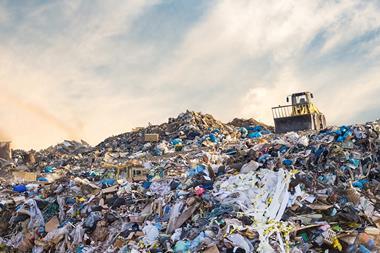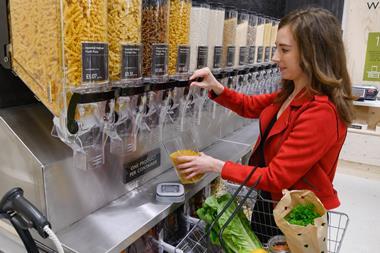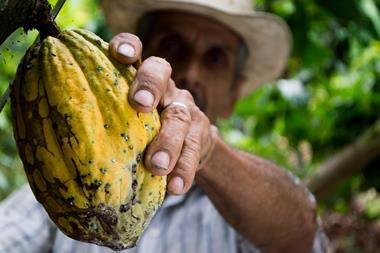In June, Tesco opened a Hinckley convenience store with waste-powered underfloor heating and sun tubes. Earlier this month, Morrisons unveiled a Kidderminster supermarket with sensors that can monitor CO2 levels from human breath. Sainsbury’s new Dartmouth store uses no gas whatsoever. And now, on the near horizon is Asda’s £16m Bootle site, which has a recycled aluminium roof.
In the 10 long years since Sainsbury’s first opened what, it claims, was the UK’s first green supermarket in Greenwich, London, there has been a procession of eco-stores, each trumping the previous one, claiming to be more eco-friendly and environmentally beneficial. But as the latest flagship opens, is this all just willy waving tokenism. Just how committed are the supermarkets to the environment?
Guided by a team of expert environmental consultants The Grocer took on the task of investigating the UK’s six biggest retailers to find out which was the greenest. It didn’t take long for the experts to realise that measuring ‘green’ is by no means an exact science. It’s not just one store, it’s all stores that need to be assessed. And while the building itself is important, it’s not even half the story. It’s 22.5% to be exact. To establish their selection, the team used 10 key environmental credentials – identified by environmental and retail consultancy Eco3 – to benchmark their performance (see boxout). All the judges agreed the retailers have made great strides in the use of renewable energy, energy efficiency and energy-saving initiatives.
“The retail food sector has embraced carbon and energy efficiency in a major way, perhaps more so than any other sector,” says Darren Ball, principal at engineering consultancy Novarama, a member of the panel. “They have moved well beyond tokenism and ‘greenwash’ and on to hard engineering initiatives.”
This is evident in the tough and in some cases immediate targets the retailers have set to reduce their carbon footprints. Sainsbury’s, for instance, aims to reduce CO2 by 25% in its stores within four years. Morrisons lays claim to being the only food retailer with the new Carbon Trust Standard – it has reduced its carbon emissions by 12.8% in the past three years alone. Tesco, meanwhile, has set itself the target of cutting the carbon footprint of its entire estate by 50% from 2006 levels by 2020.
How are retailers achieving such dramatic reductions? In-store, Tesco and Co-op have put the emphasis on reducing emissions through refrigeration usage. Energy lost through refrigerators is one of the main causes of greenhouse gas emissions in the sector. But it’s not all about reduction – the eco-friendly Tesco store in Wick has a cold air retrieval system that actually recycles as well, taking cold air from refrigerators and diverting it to cool the store room.
According to Novarama, the carbon benefit of gas-fired CHP co-generation for electricity with waste heat recovery for heating or hot water is “contentious”. Gas-fired CHP tri-generation uses waste heat, paradoxically, also for cooling but does this so inefficiently it is usually worse than conventional grid connection. Ball suggested that Tesco’s plans for 11MW of straw-fired CHP could be justified, however, because straw is virtually carbon-neutral.
The Co-op has made the furthest strides in renewable energy dependency. It has committed to generating 15% of its energy from its own wind farms by 2012. When it comes to transport and logistics, Sainsbury’s stands out in its push to improve energy efficiency, the judges agreed. In an effort to eliminate empty running vehicles, Sainsbury’s maintains daily contact with its supplier base and collects over 2,000 backhaul loads a week. Asda’s claim its electric vans for online order deliveries are 100% emission-free is challenged by the team.
“The power station that produces the electricity is about as efficient as an internal combustion engine,” says Ball. “Add to this the inefficiency of charging the battery and the total emissions are higher than a diesel van.”
Asda redeems itself, though, by providing free bus services at some stores – a simple yet effective low-carb strategy to get food to customer. Waitrose’s trial home delivery service is a bit more radical. It uses eco-bikes, trailers and even loans various forms of pedal-powered transport to customers.
Of course, many products can’t travel far without packaging. Tesco has set itself the challenging target of reducing packaging by 25% by 2010 – so far it has skimmed off around 5% during the last 12 months.
Richard Coles, consultant and lecturer in packaging and sustainable design, believes a lot of effort is needed to achieve this. But he is optimistic.
“Its proposed collaboration with brand manufacturers should generate improvements in packaging, which will help other retailers.” Sainsbury’s aims to reduce packaging weight relative to sales by 5%, against a 2004/05 baseline by 2010. Co-op also scored high on packaging – since January 2007 it claims to have reduced the level of packaging on its “primary” goods by 841 tonnes, thanks to thinner glass on 26 own-brand wine bottles, thinner salad bags and the removal of shrink wrap from cucumbers.
Another hot topic is waste. “The cost of collecting, transporting and sorting waste can be a substantial overhead and is likely to rise with increased recycling,” says Coles. Getting recycling provision up to scratch is critical, he says. “Retailers need to work closely with the waste management industry to source the needs of UK processors and find markets for recycled materials.”
Sainsbury’s agrees. “The lack of recycling facilities and infrastructure, combined with the lack of local authorities willing to accept home compostable packaging as part of green waste is a major challenge,” says a spokesperson.
But is recycling the answer? It just “postpones when waste is waste” says business innovation consultant Maria Ana Botelho Neves. “Recycling materials helps us to manage the use of scarce raw materials, but can’t solve the problems generated by the levels of consumption.”
This can only be achieved by a more sustainable approach, and this is where Co-op looks ahead of the game, adds Botelho Neves. “This retailer’s culture has sustainability embedded in its values,” she says.
It’s a view reflected in the number of community projects the Co-op runs for local schools. These include Waste Works, an education facility for school kids based at the Manchester recycling centre; and a Green Energy for Schools project, which provides them with free solar panels.
If one thing has been learned from this research, it’s that there are so many green initiatives, schemes, projects and targets out there that it’s hard to distinguish the recycled wood from the sustainably sourced trees. Still, the panel was in total agreement that retailers have gone a long way down the eco-friendly path in a short space of time. It surely can’t be long before the prized flagship eco-stores we see become the rule, and not the exception.
Sainsbury’s
Sainsbury’s was the first supermarket to launch an eco-store – in Greenwich in 1999. Its latest flagship opened in Dartmouth, Devon, last month and, of course, it raises the bar still further. It will save 40% in CO2 emissions compared with a standard store by using cutting-edge technology such as a biomass boiler to heat the building and water. The supermarket even claims to use locally sourced wood that would otherwise be wasted, and renewable energy so electricity currently taken from the national grid is slashed by 50%. The store has been designed to leak fewer draughts. And other measures – such as quiet-revolution wind turbines powering the checkouts – contribute to cutting electricity use by a third. Rainwater is collected and used to flush toilets and irrigate plants. The store plans to save one million litres of mains water every year – 60% less than on average. The use of daylight and dimming light make carbon savings, while cool air will be collected from chillers to keep the store cool in the summer. In the store’s construction recycled or recyclable materials and FSC-approved timber have been used where possible. Sainsbury’s will plant 400 trees in the community for the 200 used in the frame. Sainsbury’s even uses an eco-lorry to deliver to Dartmouth from its RDC in Bristol. The lorry runs on methane gas produced from rotting landfill. Using bio-methane can save up to 60% in CO2 emissions compared with diesel fuel. In the meantime, back in Greenwich, the store has been updated to run on the UK’s first hydrogen fuel cell. It will achieve 60% lower CO2 emissions than a standard equivalent-sized store.
Tesco
When Tesco launched its flagship eco-store in Wick in November 2006, it was one fancy green grocer: five wind turbines on its roof powered the tills; there were water-cooled refrigeration and cold-air retrieval systems; refrigeration units with LED lighting; special roof lights; rainwater collection for use in toilets and carwashes; and energy-saving ovens. But while it broke new ground at the time – and achieved a 30% smaller carbon footprint than a typical store – this is now old hat. Tesco has since opened new stores at Diss, Swansea and Shrewsbury. And in each case the footprint gets smaller and smaller. The chain is also trialling 40 green initiatives across its stores. The latest store opening, at Hinckley in Surrey, takes the battleground to a new format: convenience. It’s no less innovative, however. Timber-framed, it’s ‘thermally efficient’ – under-floor heating is powered by waste heat from the refrigeration plant. Sun pipes – tubes that let natural light in – reduce heat loss and lighting. It’s on target to cut carbon emissions by 50%. Next spring, an even greener store launches. And this one has a 70% smaller carbon footprint. So there.
Waitrose
Waitrose doesn’t have a flagship eco-store, it says. But there is one that runs on tomatoes! Its Rickmansworth store, which opened in November 2007, receives power from two Waitrose tomato farms in Chichester and Stansted through Green Energy UK. The farms’ CHP units produce heat in the form of CO2 for the greenhouses, which helps the growing process and generates electricity, purchased by Waitrose. But Waitrose aims to make a long-term difference across the entire estate and the principle of sustainability is now deep-seated into every single building project. On new builds it is ensuring that the most environmentally friendly materials are selected, the design minimises energy use and waste building materials are disposed of in the greenest possible fashion. Electricity is 100%-generated from green sources through EDF Energy. Along with the Carbon Trust it is developing commercially viable low-carbon technologies to provide a long-term alternative to fossil fuels. Solar thermal energy is also being considered for new-build shops. And since 2003, the Waitrose estate has improved its energy efficiency on existing stores by 19% and is close to its target 20% reduction by 2010. Now in the third year of a five-year store-wide programme, in which £55m will be invested in new refrigeration equipment, stores are replacing open upright freezers with cabinets with glass doors, and are using flexible doors on walk-in cold rooms. Night blinds on shopfloor open cabinets are used outside trading hours to retain cool air. Waitrose is also investigating heat reclamation from refrigeration units. Finally, in five branches in Northamptonshire, Bedfordshire and Cambridgeshire, food waste is being used to generate renewable energy, which goes back into the national grid.
In the 10 long years since Sainsbury’s first opened what, it claims, was the UK’s first green supermarket in Greenwich, London, there has been a procession of eco-stores, each trumping the previous one, claiming to be more eco-friendly and environmentally beneficial. But as the latest flagship opens, is this all just willy waving tokenism. Just how committed are the supermarkets to the environment?
Guided by a team of expert environmental consultants The Grocer took on the task of investigating the UK’s six biggest retailers to find out which was the greenest. It didn’t take long for the experts to realise that measuring ‘green’ is by no means an exact science. It’s not just one store, it’s all stores that need to be assessed. And while the building itself is important, it’s not even half the story. It’s 22.5% to be exact. To establish their selection, the team used 10 key environmental credentials – identified by environmental and retail consultancy Eco3 – to benchmark their performance (see boxout). All the judges agreed the retailers have made great strides in the use of renewable energy, energy efficiency and energy-saving initiatives.
“The retail food sector has embraced carbon and energy efficiency in a major way, perhaps more so than any other sector,” says Darren Ball, principal at engineering consultancy Novarama, a member of the panel. “They have moved well beyond tokenism and ‘greenwash’ and on to hard engineering initiatives.”
This is evident in the tough and in some cases immediate targets the retailers have set to reduce their carbon footprints. Sainsbury’s, for instance, aims to reduce CO2 by 25% in its stores within four years. Morrisons lays claim to being the only food retailer with the new Carbon Trust Standard – it has reduced its carbon emissions by 12.8% in the past three years alone. Tesco, meanwhile, has set itself the target of cutting the carbon footprint of its entire estate by 50% from 2006 levels by 2020.
How are retailers achieving such dramatic reductions? In-store, Tesco and Co-op have put the emphasis on reducing emissions through refrigeration usage. Energy lost through refrigerators is one of the main causes of greenhouse gas emissions in the sector. But it’s not all about reduction – the eco-friendly Tesco store in Wick has a cold air retrieval system that actually recycles as well, taking cold air from refrigerators and diverting it to cool the store room.
According to Novarama, the carbon benefit of gas-fired CHP co-generation for electricity with waste heat recovery for heating or hot water is “contentious”. Gas-fired CHP tri-generation uses waste heat, paradoxically, also for cooling but does this so inefficiently it is usually worse than conventional grid connection. Ball suggested that Tesco’s plans for 11MW of straw-fired CHP could be justified, however, because straw is virtually carbon-neutral.
The Co-op has made the furthest strides in renewable energy dependency. It has committed to generating 15% of its energy from its own wind farms by 2012. When it comes to transport and logistics, Sainsbury’s stands out in its push to improve energy efficiency, the judges agreed. In an effort to eliminate empty running vehicles, Sainsbury’s maintains daily contact with its supplier base and collects over 2,000 backhaul loads a week. Asda’s claim its electric vans for online order deliveries are 100% emission-free is challenged by the team.
“The power station that produces the electricity is about as efficient as an internal combustion engine,” says Ball. “Add to this the inefficiency of charging the battery and the total emissions are higher than a diesel van.”
Asda redeems itself, though, by providing free bus services at some stores – a simple yet effective low-carb strategy to get food to customer. Waitrose’s trial home delivery service is a bit more radical. It uses eco-bikes, trailers and even loans various forms of pedal-powered transport to customers.
Of course, many products can’t travel far without packaging. Tesco has set itself the challenging target of reducing packaging by 25% by 2010 – so far it has skimmed off around 5% during the last 12 months.
Richard Coles, consultant and lecturer in packaging and sustainable design, believes a lot of effort is needed to achieve this. But he is optimistic.
“Its proposed collaboration with brand manufacturers should generate improvements in packaging, which will help other retailers.” Sainsbury’s aims to reduce packaging weight relative to sales by 5%, against a 2004/05 baseline by 2010. Co-op also scored high on packaging – since January 2007 it claims to have reduced the level of packaging on its “primary” goods by 841 tonnes, thanks to thinner glass on 26 own-brand wine bottles, thinner salad bags and the removal of shrink wrap from cucumbers.
Another hot topic is waste. “The cost of collecting, transporting and sorting waste can be a substantial overhead and is likely to rise with increased recycling,” says Coles. Getting recycling provision up to scratch is critical, he says. “Retailers need to work closely with the waste management industry to source the needs of UK processors and find markets for recycled materials.”
Sainsbury’s agrees. “The lack of recycling facilities and infrastructure, combined with the lack of local authorities willing to accept home compostable packaging as part of green waste is a major challenge,” says a spokesperson.
But is recycling the answer? It just “postpones when waste is waste” says business innovation consultant Maria Ana Botelho Neves. “Recycling materials helps us to manage the use of scarce raw materials, but can’t solve the problems generated by the levels of consumption.”
This can only be achieved by a more sustainable approach, and this is where Co-op looks ahead of the game, adds Botelho Neves. “This retailer’s culture has sustainability embedded in its values,” she says.
It’s a view reflected in the number of community projects the Co-op runs for local schools. These include Waste Works, an education facility for school kids based at the Manchester recycling centre; and a Green Energy for Schools project, which provides them with free solar panels.
If one thing has been learned from this research, it’s that there are so many green initiatives, schemes, projects and targets out there that it’s hard to distinguish the recycled wood from the sustainably sourced trees. Still, the panel was in total agreement that retailers have gone a long way down the eco-friendly path in a short space of time. It surely can’t be long before the prized flagship eco-stores we see become the rule, and not the exception.
Sainsbury’s
Sainsbury’s was the first supermarket to launch an eco-store – in Greenwich in 1999. Its latest flagship opened in Dartmouth, Devon, last month and, of course, it raises the bar still further. It will save 40% in CO2 emissions compared with a standard store by using cutting-edge technology such as a biomass boiler to heat the building and water. The supermarket even claims to use locally sourced wood that would otherwise be wasted, and renewable energy so electricity currently taken from the national grid is slashed by 50%. The store has been designed to leak fewer draughts. And other measures – such as quiet-revolution wind turbines powering the checkouts – contribute to cutting electricity use by a third. Rainwater is collected and used to flush toilets and irrigate plants. The store plans to save one million litres of mains water every year – 60% less than on average. The use of daylight and dimming light make carbon savings, while cool air will be collected from chillers to keep the store cool in the summer. In the store’s construction recycled or recyclable materials and FSC-approved timber have been used where possible. Sainsbury’s will plant 400 trees in the community for the 200 used in the frame. Sainsbury’s even uses an eco-lorry to deliver to Dartmouth from its RDC in Bristol. The lorry runs on methane gas produced from rotting landfill. Using bio-methane can save up to 60% in CO2 emissions compared with diesel fuel. In the meantime, back in Greenwich, the store has been updated to run on the UK’s first hydrogen fuel cell. It will achieve 60% lower CO2 emissions than a standard equivalent-sized store.
Tesco
When Tesco launched its flagship eco-store in Wick in November 2006, it was one fancy green grocer: five wind turbines on its roof powered the tills; there were water-cooled refrigeration and cold-air retrieval systems; refrigeration units with LED lighting; special roof lights; rainwater collection for use in toilets and carwashes; and energy-saving ovens. But while it broke new ground at the time – and achieved a 30% smaller carbon footprint than a typical store – this is now old hat. Tesco has since opened new stores at Diss, Swansea and Shrewsbury. And in each case the footprint gets smaller and smaller. The chain is also trialling 40 green initiatives across its stores. The latest store opening, at Hinckley in Surrey, takes the battleground to a new format: convenience. It’s no less innovative, however. Timber-framed, it’s ‘thermally efficient’ – under-floor heating is powered by waste heat from the refrigeration plant. Sun pipes – tubes that let natural light in – reduce heat loss and lighting. It’s on target to cut carbon emissions by 50%. Next spring, an even greener store launches. And this one has a 70% smaller carbon footprint. So there.
Waitrose
Waitrose doesn’t have a flagship eco-store, it says. But there is one that runs on tomatoes! Its Rickmansworth store, which opened in November 2007, receives power from two Waitrose tomato farms in Chichester and Stansted through Green Energy UK. The farms’ CHP units produce heat in the form of CO2 for the greenhouses, which helps the growing process and generates electricity, purchased by Waitrose. But Waitrose aims to make a long-term difference across the entire estate and the principle of sustainability is now deep-seated into every single building project. On new builds it is ensuring that the most environmentally friendly materials are selected, the design minimises energy use and waste building materials are disposed of in the greenest possible fashion. Electricity is 100%-generated from green sources through EDF Energy. Along with the Carbon Trust it is developing commercially viable low-carbon technologies to provide a long-term alternative to fossil fuels. Solar thermal energy is also being considered for new-build shops. And since 2003, the Waitrose estate has improved its energy efficiency on existing stores by 19% and is close to its target 20% reduction by 2010. Now in the third year of a five-year store-wide programme, in which £55m will be invested in new refrigeration equipment, stores are replacing open upright freezers with cabinets with glass doors, and are using flexible doors on walk-in cold rooms. Night blinds on shopfloor open cabinets are used outside trading hours to retain cool air. Waitrose is also investigating heat reclamation from refrigeration units. Finally, in five branches in Northamptonshire, Bedfordshire and Cambridgeshire, food waste is being used to generate renewable energy, which goes back into the national grid.









No comments yet